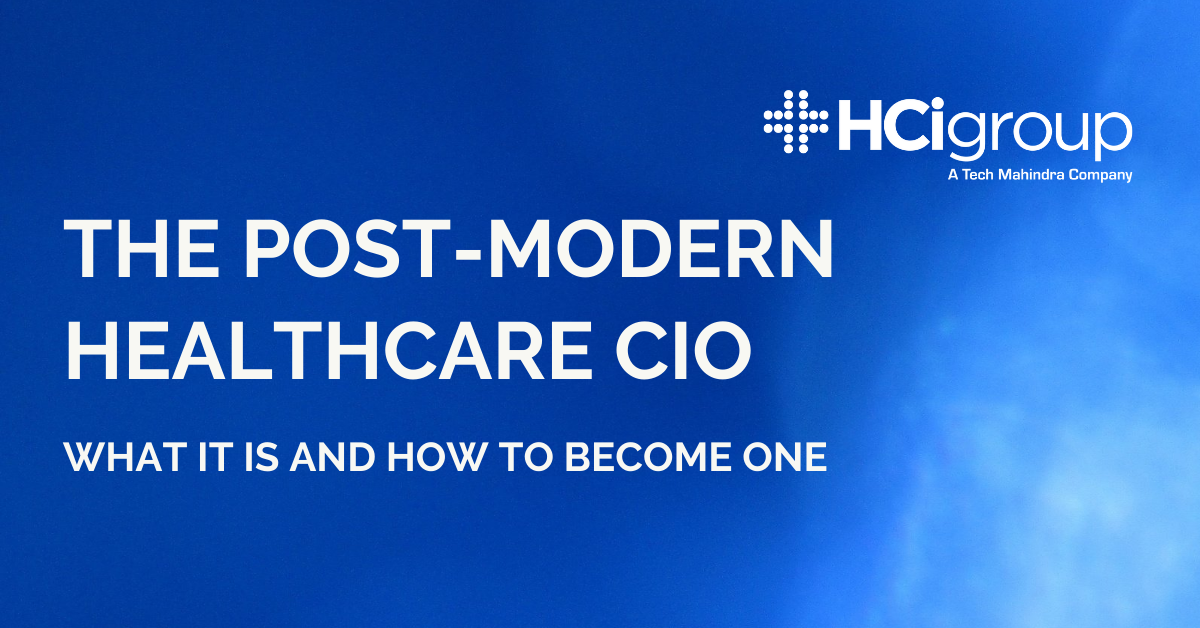The Post-modern Healthcare CIO: What It is and How to Become One


A modern healthcare CIO may be able to thoroughly describe their organization’s IT strategy in terms of technical tactics like migrating to the cloud and doing app rationalization. But a postmodern CIO will relate their company’s IT strategy to the healthcare provider’s broader goals, like to touch more lives.
“‘Touching lives’ doesn’t sound very IT or techie because it isn’t. But if you peel back the layers you might learn that it’s all about enabling virtual care so that you can treat more patients in a world without borders,” says Ed Marx, Chief Digital Officer for The HCI Group. “That’s an example of the differences between a modern and post-modern CIO for a healthcare organization.”Whereas a modern CIO is about IT, a post-modern healthcare CIO is about business strategy, Marx explained. “You should walk into a C-suite and have a hard time differentiating who’s who in terms of their role. That’s when you know you have a post-modern CIO,” he says.
Evolving Expectations for CIOs
As a business leader, the post-modern CIO sees beyond IT. Healthcare organizations look to them for innovation, digital transformation and revenue generation as they cast off traditional IT roles. In many instances, the CIO’s transformational role is even evolving to “COO by proxy” as healthcare organizations realize the value that they can produce by aligning technology and business strategy.
Knowing how to support organizational objectives with technology is essential to becoming a post-modern CIO, says Will Conaway, Chief Growth Officer & Vice President of Provider Delivery at The HCI Group.
“As you move up the ladder, it becomes more important to know all of what’s going on so you can see the whole landscape,” he says. “When you are talking with executives, they want to know how technology can support regulations that are coming up or how you can tie technology to the overall health of the organization, for example.”
If executives do not get such answers from within their organizations, they will hire someone who can provide the information, even if they have not worked in healthcare. Pressed to transform like other industries before it, many of the industry’s new healthcare chief digital officers have come from outside of healthcare.
CIOs must develop skills and expand their roles if they do not want their organizations to bring in a chief digital officer or similar leader from outside. Re-tooling skills and reshaping roles also help health IT leaders advance in their careers, including those CIOs at small or medium organizations that may be more involved in day-to-day IT tasks than their counterparts at large health systems.
Defining a Post-Modern Healthcare CIO
Post-modern healthcare IT enables the digital transformation that organizations must make to thrive in a patient-centric future, Marx says. A post-modern CIO makes that happen, he says, by:
- Driving agility
- Embracing best practices
- Acting strategically
- Focusing on experiences
- Living lean
Similarly, McKinsey & Company describes a transformative CIO as a:
- Business leader
- Change agent
- Talent scout
- Culture revolutionary
- Tech translator
“You’ve got to do everything with excellence. That’s what a post-modern CIO does,” Marx says. “They don’t sit around waiting for something to happen.”
Becoming a Post-Modern Healthcare CIO
Your personal brand and professional development are crucial in advancing your career, according to Conaway. “You have to be continuously learning. The minute you stop learning, you stop growing,” he says.
People skills are particularly important in pursuing opportunities and become even more vital as you rise higher, Conaway notes. “You have to be able to get people to follow you and to follow you for the right reasons,” he says.
Conaway says you need seven types of people in your network to have a strong and successful career.
- Confidants
- Champions
- Collaborators
- Call On’s
- Connectors
- Coaches
- Counselors
“You have to go out there and actively seek connections. Let people know you’re looking and prove that you’re ready,” Conaway says.
Proving that you have the skills needed to be a post-modern CIO is increasingly important as more healthcare organizations look for such leaders. Technology wherewithal alone is no longer enough. Business strategy is now a must.
Three Ways to Prepare Yourself for Becoming a Post-Modern CIO
1) Create a strategic plan. Conaway recommends approaching your career like a project. Choose a target organization that would align with your mission, vision and values. Do a gap analysis that compares your skills with those that organizations look for in CIOs. Set objectives. Establish metrics and monitor your progress.
2) Find a mentor. Leadership is caught not taught, Marx says. Learn from strong leaders and leverage their help.
3) Get involved. Conaway and Marx recommend participating in professional organizations like CHIME and HIMSS. They offer many opportunities to learn and network.
